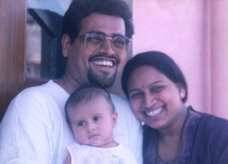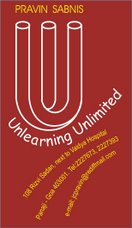The Marathi film, “Majhi Goshta” (My Story) was screened on last Friday at the International Centre, Goa. The film reveals the travails and the travel of a schizophrenic patient who gets timely help and guidance to discover his self-actualisation in music. The screening was followed by a discussion with acclaimed actor and psychiatrist, Dr Mohan Agashe.
During the discussion, a lady raised a very pertinent point… Films like Taare Zameen Par and Mhaji Goshta generally tend to show protagonists overcoming the handicaps of dyslexia and schizophrenia due to possessing talents like painting or music. She wondered whether this would convey rare exceptions as a rule and hence create a wrong impression in the minds of the audience.
In response to the query, Agashe chose to show another movie – a one-minute animation film made as part of a contest in Chennai. The movie showed a handicapped person being asked about his forte. The questioner was consistent in hurling his queries… Can you paint? Can you sing? Can you do something special? Each time the answer was a humble “no” till the person at the receiving end turned around and asked, “Can you (do any of the things you expect me to do)?”
Too often, we insist that our children, subordinates and others should be extraordinary personalities with gifted specialities. Looking around, we will notice that it is not the people with the best talents or techniques who make a huge difference, but it is the people with the right temperament. We need to be better (at inculcating in ourselves and encouraging in others) the real forte - the right attitude! And the right attitude is one that ensures a developmental approach rather than a judgemental one.
Do not fret and frown at the handicap of a lesser aptitude…
Genuine forte is to BE BETTER at empowering a noble attitude!
- Pravin
Monday, February 23, 2009
Monday, February 9, 2009
A PATCH OF HUMOUR
A woman had a below-knee amputation as a result of having diabetes and smoking all of her life. When she was regaining consciousness in the Recovery Unit, her doctor-son smiled at her and said ‘Well mum, how does it feel to have one leg in the grave?’ She laughed out loud. Till the day she died, she told that story to her friends and each time, she laughed again.
The son, Dr. Patch Adams is an inspirational icon who has changed the despair of his patients with his cheerful clowning! Convinced of the powerful connection between environment and health, he employed many creative ways in using humour to bring hope and healing to his patients... including dressing up like a clown and decorating the patient’s bed with colourfull balloons. Along with friends, Patch founded a model "happy" hospital – the Gesundheit Institute – where the pain of patients is treated with a patch of humour.
Humour helps because smiling and laughing triggers the secretions of morphine-like chemicals known as endorphins. Endorphins strengthen the immune system (responsible for fighting disease and enhancing recovery), reduce pain, and relax the body. Humour also works because it distracts people from their worries and pain and it restores perspective. Humour doesn’t alter the situation, but it helps you to cope with the pain.
Surely, we can learn from the example of Dr. Patch Adams. Surely we can “be better” at facing every despair with a genuine display of care and humour. Surely we can spread cheer and hope by lifting the spirits of those who seem to have succumbed to the situation. And of course, we must start with our own selves by seeing the positives in every problem that seizes us!
To BE BETTER at taking every hindrance head-on
We must choose to sing the positive humour song…
- Pravin
The son, Dr. Patch Adams is an inspirational icon who has changed the despair of his patients with his cheerful clowning! Convinced of the powerful connection between environment and health, he employed many creative ways in using humour to bring hope and healing to his patients... including dressing up like a clown and decorating the patient’s bed with colourfull balloons. Along with friends, Patch founded a model "happy" hospital – the Gesundheit Institute – where the pain of patients is treated with a patch of humour.
Humour helps because smiling and laughing triggers the secretions of morphine-like chemicals known as endorphins. Endorphins strengthen the immune system (responsible for fighting disease and enhancing recovery), reduce pain, and relax the body. Humour also works because it distracts people from their worries and pain and it restores perspective. Humour doesn’t alter the situation, but it helps you to cope with the pain.
Surely, we can learn from the example of Dr. Patch Adams. Surely we can “be better” at facing every despair with a genuine display of care and humour. Surely we can spread cheer and hope by lifting the spirits of those who seem to have succumbed to the situation. And of course, we must start with our own selves by seeing the positives in every problem that seizes us!
To BE BETTER at taking every hindrance head-on
We must choose to sing the positive humour song…
- Pravin
Monday, February 2, 2009
RAGE CONTROL
An ancient Zen story tells the tale of a young man who easily succumbed to the emotion of anger. The aftermath of his uncontrollable fury would leave him regretting his words, actions and behaviour. He wished to control his unruly rage and went seeking solution from a renowned Zen Master.
On meeting the Master, he complained: "Master, I have an ungovernable temper. How can I cure it?" The Master calmly replied, "You have something very strange. Can I see what you have?" The young man was stunned with the bizarre request. He replied, “But Master, I am not angry, right now… hence I cannot show it to you."
The master persisted, "so when can you show it to me?" The young man responded,
"My anger arises unexpectedly. I cannot say when it might seize me again…” Immediately, the wise man proclaimed, "then surely, it must not be your own true nature. If it were, you could show it to me at any time."
To BE BETTER at overcoming and managing the emotion of anger, we must first accept responsibility and then take control of our thoughts and behaviour. So often we delude ourselves by believing that negative behavioural traits are habits that cannot be overwhelmed. But we need to remind ourselves, that restraining rage is just like controlling any other destructive habit. Like other habits, we have acquired it… and like other habits it can be unlearnt.
It is we who picked up rage as just another regressive habit…
To BE BETTER at being in control, it is we who must drop it!
- Pravin
On meeting the Master, he complained: "Master, I have an ungovernable temper. How can I cure it?" The Master calmly replied, "You have something very strange. Can I see what you have?" The young man was stunned with the bizarre request. He replied, “But Master, I am not angry, right now… hence I cannot show it to you."
The master persisted, "so when can you show it to me?" The young man responded,
"My anger arises unexpectedly. I cannot say when it might seize me again…” Immediately, the wise man proclaimed, "then surely, it must not be your own true nature. If it were, you could show it to me at any time."
To BE BETTER at overcoming and managing the emotion of anger, we must first accept responsibility and then take control of our thoughts and behaviour. So often we delude ourselves by believing that negative behavioural traits are habits that cannot be overwhelmed. But we need to remind ourselves, that restraining rage is just like controlling any other destructive habit. Like other habits, we have acquired it… and like other habits it can be unlearnt.
It is we who picked up rage as just another regressive habit…
To BE BETTER at being in control, it is we who must drop it!
- Pravin
Subscribe to:
Comments (Atom)



